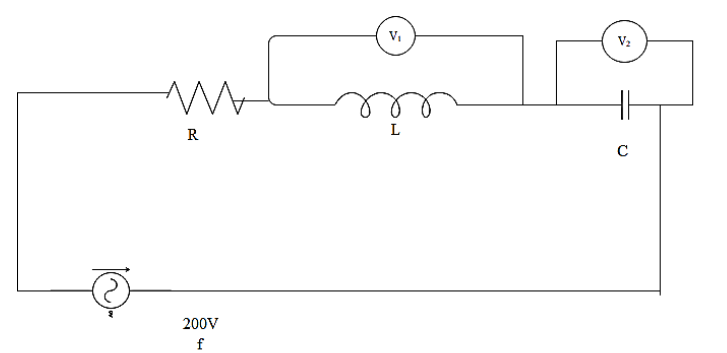
In the figure shown,


Answer
499.2k+ views
Hint The voltage across the inductor and capacitors are the same. Therefore the circuit will be in resonance. Frequency of the source can be found by taking the reciprocal of the product of the constant
Complete answer:
As it is mentioned in the question that the voltage across the inductor and the capacitor are equal, we can write that,
The voltage across the capacitor can be found by the equation,
Where
The voltage across the inductor will be written as,
Where
As the voltages are equal we can write that,
The frequency of the source can be found using the equation,
The value of capacitance and inductance are given in the question,
Substituting this in the equation will give,
Therefore option A is correct and option B is incorrect.
The current through the circuit will be the same for every component as they are in series connection.
The current through the circuit is,
Where
As the circuit is in resonance,
Substituting this in the equation will give,
The voltage of the source and resistance are given as,
Substituting this in the equation,
Therefore the option C is also correct.
The voltage across inductor is found by the equation,
Substituting the values in it will give,
As the voltage across inductor and capacitor are same,
Therefore option D is also correct.
We can conclude that option A, C, D are correct.
Note:
The LCR series circuit is also known as a resonance circuit. The impedance is very low at resonance. Therefore the current will be high. The high value of current at resonance develops very high values of voltage across the inductor and capacitor.
Complete answer:
As it is mentioned in the question that the voltage across the inductor and the capacitor are equal, we can write that,
The voltage across the capacitor can be found by the equation,
Where
The voltage across the inductor will be written as,
Where
As the voltages are equal we can write that,
The frequency of the source can be found using the equation,
The value of capacitance and inductance are given in the question,
Substituting this in the equation will give,
Therefore option A is correct and option B is incorrect.
The current through the circuit will be the same for every component as they are in series connection.
The current through the circuit is,
Where
As the circuit is in resonance,
Substituting this in the equation will give,
The voltage of the source and resistance are given as,
Substituting this in the equation,
Therefore the option C is also correct.
The voltage across inductor is found by the equation,
Substituting the values in it will give,
As the voltage across inductor and capacitor are same,
Therefore option D is also correct.
We can conclude that option A, C, D are correct.
Note:
The LCR series circuit is also known as a resonance circuit. The impedance is very low at resonance. Therefore the current will be high. The high value of current at resonance develops very high values of voltage across the inductor and capacitor.
Recently Updated Pages
Master Class 12 Business Studies: Engaging Questions & Answers for Success

Master Class 12 English: Engaging Questions & Answers for Success

Master Class 12 Social Science: Engaging Questions & Answers for Success

Master Class 12 Chemistry: Engaging Questions & Answers for Success

Class 12 Question and Answer - Your Ultimate Solutions Guide

Master Class 11 Economics: Engaging Questions & Answers for Success

Trending doubts
Draw a labelled sketch of the human eye class 12 physics CBSE

a Tabulate the differences in the characteristics of class 12 chemistry CBSE

Which one of the following is a true fish A Jellyfish class 12 biology CBSE

Why is the cell called the structural and functional class 12 biology CBSE

Differentiate between homogeneous and heterogeneous class 12 chemistry CBSE

Write the difference between solid liquid and gas class 12 chemistry CBSE




